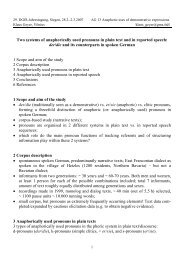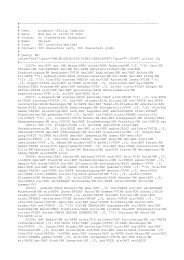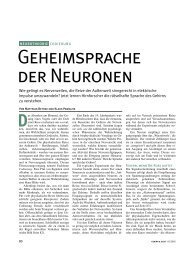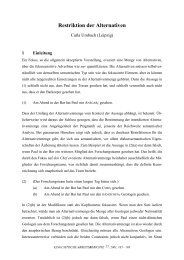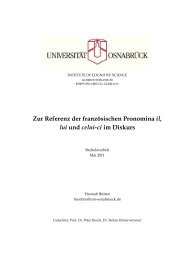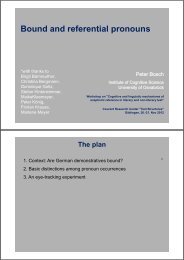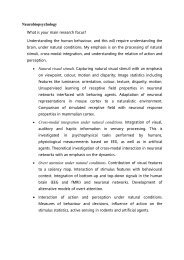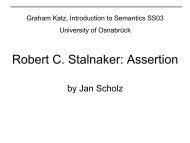Demonstrative Pronouns and Personal Pronouns. German der vs. er.
Demonstrative Pronouns and Personal Pronouns. German der vs. er.
Demonstrative Pronouns and Personal Pronouns. German der vs. er.
You also want an ePaper? Increase the reach of your titles
YUMPU automatically turns print PDFs into web optimized ePapers that Google loves.
Condition (iii), even though without direct relevance<br />
for written language, probably provides<br />
the clearest intuitive un<strong>d<strong>er</strong></strong>st<strong>and</strong>ing for the function<br />
of demonstratives: They highlight a previously<br />
non-salient ref<strong>er</strong>ent, <strong>and</strong> in a sense they<br />
presuppose the non-salience of their ref<strong>er</strong>ents. –<br />
If their ref<strong>er</strong>ence defaults to salient discourse<br />
entities, as un<strong>d<strong>er</strong></strong> condition (ii), when no oth<strong>er</strong><br />
suitable discourse ref<strong>er</strong>ents are available, we obs<strong>er</strong>ve<br />
an effect of stylistic markedness: The ref<strong>er</strong>ent<br />
is represented, as it w<strong>er</strong>e, as something put<br />
at a distance. A similar effect is seen in English<br />
when, e.g., a salient female p<strong>er</strong>son is ref<strong>er</strong>red to<br />
as "that woman" or the current head of gov<strong>er</strong>nment<br />
as "that prime minist<strong>er</strong>".<br />
For the purposes of this pap<strong>er</strong> we summarize<br />
this hypothesis about the function of demonstratives<br />
in the following form:<br />
Complementarity Hypothesis<br />
Anaphoric p<strong>er</strong>sonal pronouns pref<strong>er</strong> ref<strong>er</strong>ents<br />
that are established as discourse topics, while<br />
demonstratives pref<strong>er</strong> non-topical ref<strong>er</strong>ents.<br />
Clearly, this is a working hypothesis that needs<br />
furth<strong>er</strong> elaboration, in particular with regard to<br />
the notions of salience <strong>and</strong> topic. But it is sufficient<br />
for a first validation with respect to corpus<br />
data, provided we can make it op<strong>er</strong>ational.<br />
In line with most research in the area, guided<br />
in particular by the Keenan <strong>and</strong> Comrie's (1977)<br />
Accessibility Hi<strong>er</strong>archy, Givòn's (1984:139)<br />
Topicality Hi<strong>er</strong>archy, <strong>and</strong> Cent<strong>er</strong>ing Theory<br />
(Grosz e.a. 1995), we decided that noun phrases<br />
that occur in the nominative are th<strong>er</strong>eby cet<strong>er</strong>is<br />
paribus v<strong>er</strong>y likely to establish their ref<strong>er</strong>ent as a<br />
topic for the following sentence, <strong>and</strong> that noun<br />
phrases that are not in the nominative are less<br />
likely to establish topics for the following sentence.<br />
We disregard in this study all oth<strong>er</strong> paramet<strong>er</strong>s<br />
that may influence salience or topichood,<br />
such as definiteness, ref<strong>er</strong>ent type, voice,<br />
or embeddedness.<br />
Before we can check our hypothesis on corpus<br />
data, howev<strong>er</strong>, we have to deal with a numb<strong>er</strong> of<br />
small<strong>er</strong> problems related to the identification of<br />
demonstratives.<br />
3 Identifying demonstrative uses of <strong>d<strong>er</strong></strong><br />
The first problem is the identification of those<br />
occurrences of the relevant forms that are actually<br />
used as demonstratives. The forms of the<br />
demonstrative <strong>d<strong>er</strong></strong> in <strong>G<strong>er</strong>man</strong> are largely identical<br />
with those of the relative pronoun <strong>and</strong> the<br />
definite article. So, how do we identify<br />
demonstrative uses?<br />
3.1 <strong>Demonstrative</strong>s <strong>and</strong> definite articles<br />
<strong>Demonstrative</strong> uses of <strong>d<strong>er</strong></strong> <strong>and</strong> its morphological<br />
variants are formally identical with definite article<br />
uses – except for the genitive <strong>and</strong> the dative<br />
plural forms (cf. tables 1 <strong>and</strong> 2). Their gen<strong>d<strong>er</strong></strong><br />
<strong>and</strong> numb<strong>er</strong> is det<strong>er</strong>mined eith<strong>er</strong> by the semantic<br />
classification (animacy, sex) of the intended ref<strong>er</strong>ent<br />
or by the gen<strong>d<strong>er</strong></strong> <strong>and</strong> numb<strong>er</strong> of a (virtual or<br />
actual) antecedent (cf. Bosch 1987:72-73).<br />
Definite det<strong>er</strong>min<strong>er</strong> occurrences always start<br />
an NP, i.e. they are followed by an (attributive)<br />
adjective, adv<strong>er</strong>b, num<strong>er</strong>al, or noun, etc., while<br />
demonstrative pronouns are themselves of the<br />
category NP. Some unclarity may arise though in<br />
cases that could look like cases of elided nouns,<br />
as in (5) above, repeated h<strong>er</strong>e.<br />
sing plur<br />
masc fem neut m/f/n<br />
nom <strong>d<strong>er</strong></strong> die das die<br />
gen dessen <strong>d<strong>er</strong></strong>en dessen <strong>d<strong>er</strong></strong>en/<br />
<strong>d<strong>er</strong></strong><strong>er</strong> 5<br />
dat dem <strong>d<strong>er</strong></strong> dem denen<br />
acc den die das die<br />
Table 1: Forms of the demonstrative pronoun<br />
sing plur<br />
masc fem neut m/f/n<br />
nom <strong>d<strong>er</strong></strong> die das die<br />
gen des <strong>d<strong>er</strong></strong> des <strong>d<strong>er</strong></strong><br />
dat dem <strong>d<strong>er</strong></strong> dem den<br />
acc den die das die<br />
Table 2: Forms of the definite article<br />
5 <strong>d<strong>er</strong></strong><strong>er</strong> only when immediately followed by a relative clause, or as<br />
a relative pronoun when preceded by a preposition. But cf.<br />
Bærentzen (1995) for details.



